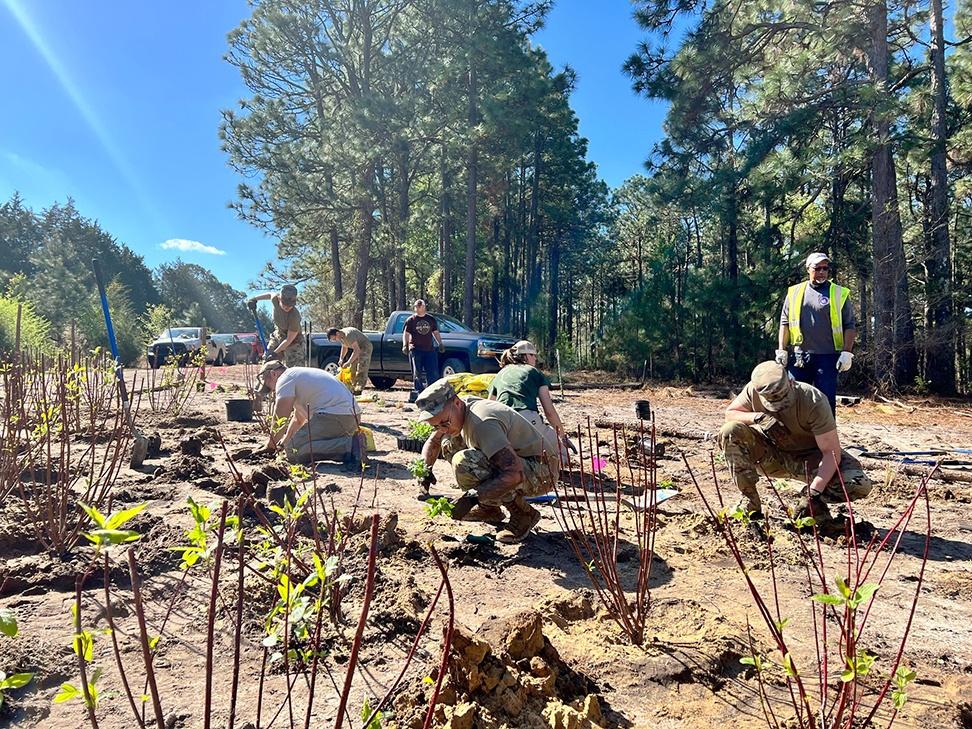
"Natural resources, for the most part, become cultural resources and serve many diverse life-saving functions," wrote Linda Carnes -McNaughton, curator, Cultural Resources Management Program, Fort Bragg Directorate of Public Works (DPW).
This is how Carnes -McNaughton opened a National Public Lands Grant application for a Native American Pollinator Garden on Fort Bragg. The grant was awarded in the Spring of 2019 for $9,500. Then COVID-19 lockdowns began in Spring 2020, and the garden project was indefinitely delayed. Eventually, the funds awarded for the garden were reallocated, and the project was in limbo.
That is until Carnes-McNaughton, and the Fort Bragg Arbor Board breathed new life into the project.
This new life has seen the project metamorphose into a three-phase plan and be located in a new place. Originally, the garden was to be placed near McKellar's Lodge, but with the inception of the Liberty Trail, a series of parks and green spaces planned to connect throughout Fort Bragg, the garden was moved to the Willow Lakes Park near Pope Army Airfield. A triangular tract of land at a trail intersection was selected, and the final part of what Carnes-McNaughton describes as Phase I was completed.
Phase I of the project involved the adaptation of the concept, planning, plant selection and purchase, and finally, planting the garden.
The choice of each plant and the placement of each plant are rife with meaning and importance. Carnes-McNaughton designed the garden with collaboration in mind. The plan was to engage and include local Native American youths and Army communities, building a platform for interaction between the military community and the Catawba nation. The garden will be a place for education, teaching the public about the types of native plants with cultural, historical and natural importance.
"It was correspondence back and forth with the Catawba nation, and they are one of our geographically closest federally-recognized consulting groups," Carnes McNaughton said. "They have helped us select the plants and narrow it down to the ten we are putting in this special garden."
While Carnes-McNaughton consulted primarily with the Catawba nation about the plant choices for the garden, this consultation was done in tandem with insights of the Fort Bragg botanist and DPW's Endangered Species Branch.
The ten plants were chosen, all serve a purpose as pollinators, and all have cultural uses. Butterfly weed, Asclepias turberosa, can be used for cordage, medicine and benefits the Monarch butterfly. American Beautyberry, Callicarpa americana, can treat malarial fever, colic and dysentery. Tea made from New Jersey Tea, Ceanothus americanus, treats upper respiratory illness, is a natural caffeine source, and the roots can be used for astringents. Purple Thistle, Cirsium repandum, is used to make blow darts. Woodland Sunflower, Helianthus divaricatus, is edible and a major pollinator. Blue Wild Indigo, Baptisia australis, is used for tea and is a blue clothing dye. Pawpaw, Asimina tribola, produces an edible fruit and can be made into a yellow dye.
"[Native peoples] used plants intimately in everything they did all their daily lives. Whether it was a medicinal, ritual or even cosmetically or eating," Carnes-McNaughton said.
With the help of soldiers, members of DPW and the military community, the garden was planted last Wednesday, April 6. In the next phase, Phase II, Carnes-McNaughton said visitors to the garden would see the addition of trilingual interpretive signage and the addition of a traditional wattle fence. A more prominent ign will be placed at one of the triangle's vertices. This sign will describe the garden. Additional signs will be placed with each plant species that will list the common name of each plant, the Latin name, and the Native American name and detail the plants' function and use within Native American culture.
"If we have the opportunity on the signage, it might include what I think is cool, illustrations of some of the hand tools that they [Native Americans] used to cultivate and harvest these plants," Carnes-McNaughton said.
The traditional wattle fencing will also be added and will likely be made using willow saplings. A wattle fence is created by weaving long green and bendable saplings through larger stakes. The result is a basketweave textured traditional Native American style fence. The hope is that Native American youths and perhaps an Eagle Scout group will be able to help build the fence; this would align with the themes of collaboration, education and public engagement central to the garden's inception and design.
Harvesting and maintenance are Phase III of the garden plan. This will ideally involve the Catawba and the public. The overall goal of the project is education.
"The educational component, think of it as an outdoor classroom or what we call a demonstration project to educate the public on the types of plants and not only for their wildlife value but their cultural and historical significance," said Carnes-McNaughton.

 How to resolve AdBlock issue?
How to resolve AdBlock issue? 








